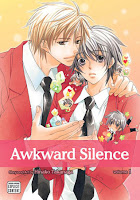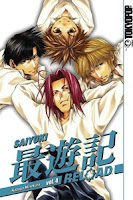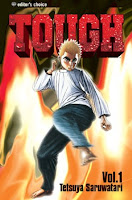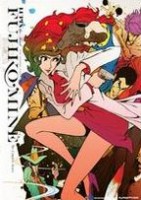My News and Reviews
Well, the biggest news from last week (at least for me and Experiments in Manga) is that I have officially joined the Manga Bookshelf family of blogs. I posted an introductory post for new readers and anyone else interested in learning a little more about me or Experiments in Manga. I’m still getting used to WordPress, and I still have some cleaning up to do, so if you notice anything amiss, I’d appreciate you letting me know!
I also posted a review of Edogawa Rampo’s collection of short stories Japanese Tales of Mystery and Imagination. Originally released in 1956, the volume was Rampo’s English-language debut. I had previously read and enjoyed Rampo’s novella Strange Tale of Panorama Island which is why I sought out more of his work. (And on a related note: Suehiro Maruo’s The Strange Tale of Panorama Island is also marvelous.)
I also had the opportunity to help out manga critic Jason Thompson last week (who I credit as one of the major reasons I became so interested in manga.) If you’re in Vancouver, Washington this coming Sunday, Jason is presenting “Manga Hell: The Worst Manga Ever Translated” at Kumoricon. It should be pretty great. I was able to provide some images of choice pages from Kazuo Koike and Ryoichi Ikegami’s notorious manga series Wounded Man. (I first learned about Wounded Man thanks when it was selected for Kate Dacey’s Manga Hall of Shame.)
On to a few interesting things found online! I either completely missed this when it was first announced or simply forgot about it, but Bento Books has licensed five novels from Hayakawa Publishing: Hiroko Minakawa’s Pleased to Dissect You, Yuka Nakazato’s Silver Wings of the Campanula, Yu Godai’s, Quantum Devil Saga: Avatar Tuner, Volume 1, Akimaro Mori’s The Black Cat Takes a Stroll, and Issui Ogawa’s Many Many Sheep. It’s an intriguing mix of fantasy, science fiction, and mystery and quite a change of pace from Bento’s first release Math Girls.
In other licensing news, Sean Gaffney has a roundup of the Japan Expo announcements from this weekend. Finally, if you have the time I recommend giving the most recent ANNCast episode a listen–Super Manga Pals Forever. The always marvelous Deb Aoki and Rebecca Silverman join host Zac Bertschy to talk about the manga they’ve been reading and discuss the use of rape and taboos as plot elements in entertainment media. (Warning: Spoilers for the ninth volume of Yumi Unita’s Bunny Drop if by some chance you haven’t been spoiled already.)
Quick Takes
 Attack on Titan, Volume 6 by Hajime Isayama. Despite the issues that I have with the art in Attack on Titan, which admittedly has been improving, I continue to be utterly absorbed and engaged by the story. The sixth volume picks up right where the fifth volume left off with the appearance of a new, seemingly intelligent, but still incredibly dangerous titan. It’s mostly one long action sequence as the titans tear through the ranks of the Survey Corps. Unsurprisingly, there are quite a few messy deaths. However, there’s a bit of character development as well. In particular, more is reveled about the members of the Special Operations Squad charged with guarding Eren who are also responsible for killing him should he get out of hand. The ending sets things up nicely for some major plot reveals in the next volume. Fortunately Kodansha has sped up the series release, so it won’t be too long of a wait to find out what happens next.
Attack on Titan, Volume 6 by Hajime Isayama. Despite the issues that I have with the art in Attack on Titan, which admittedly has been improving, I continue to be utterly absorbed and engaged by the story. The sixth volume picks up right where the fifth volume left off with the appearance of a new, seemingly intelligent, but still incredibly dangerous titan. It’s mostly one long action sequence as the titans tear through the ranks of the Survey Corps. Unsurprisingly, there are quite a few messy deaths. However, there’s a bit of character development as well. In particular, more is reveled about the members of the Special Operations Squad charged with guarding Eren who are also responsible for killing him should he get out of hand. The ending sets things up nicely for some major plot reveals in the next volume. Fortunately Kodansha has sped up the series release, so it won’t be too long of a wait to find out what happens next.
 Awkward Silence, Volumes 1-3 by Hinako Takanaga. I tend to be fond of Takanaga’s boys’ love manga and so was happy when SuBLime picked up one of her ongoing series. Normally, I’m annoyed by manga where the plot hinges on a problem that would immediately be solved if the characters would just talk to one another. But in the case of Awkward Silence I didn’t mind as much because there is a very good reason that the characters don’t–Satoru has a difficult time expressing himself. It’s an integral part of his character and integral part of the story. One of the points of the series is that he and his boyfriend Keigo learn to overcome this. Their relationship is really quite sweet. Beginning with the third volume Awkward Silence starts to focus more on two of the secondary characters. (At least they started out as secondary characters.) Personally, I don’t find their relationship to be nearly as interesting. While still enjoyable, it feels more generic. Unlike the main couple, so far it’s missing something to really set it apart.
Awkward Silence, Volumes 1-3 by Hinako Takanaga. I tend to be fond of Takanaga’s boys’ love manga and so was happy when SuBLime picked up one of her ongoing series. Normally, I’m annoyed by manga where the plot hinges on a problem that would immediately be solved if the characters would just talk to one another. But in the case of Awkward Silence I didn’t mind as much because there is a very good reason that the characters don’t–Satoru has a difficult time expressing himself. It’s an integral part of his character and integral part of the story. One of the points of the series is that he and his boyfriend Keigo learn to overcome this. Their relationship is really quite sweet. Beginning with the third volume Awkward Silence starts to focus more on two of the secondary characters. (At least they started out as secondary characters.) Personally, I don’t find their relationship to be nearly as interesting. While still enjoyable, it feels more generic. Unlike the main couple, so far it’s missing something to really set it apart.
 Saiyuki Reload, Volumes 4-6 by Kazuya Minekura. Although I was a little disappointed with the first three volumes of Saiyuki Reload, much preferring the earlier series Saiyuki, I think that Minekura has started to find her stride again. These volumes finish up the long flashback/backstory segement which included a look at Gojyo and Hakkai’s past when they were living together. (I’m a sucker for Hakkai, so I rather enjoyed that.) From there, Saiyuki Reload starts in on a new story arc, giving the plot the focus and direction that it needed. While the first few volumes of the series didn’t seem to be going anywhere, with the introduction of Hazel things are starting to get a bit more interesting. Sanzo and crew are faced with several moral conundrums and suddenly their journey west has some urgency behind it again. And speaking of The Journey to the West–the influences of the original work can definitely be seen. They aren’t always particularly prominent and Minekura is often very free with her interpretations, but The Journey to the West can still be found in there somewhere.
Saiyuki Reload, Volumes 4-6 by Kazuya Minekura. Although I was a little disappointed with the first three volumes of Saiyuki Reload, much preferring the earlier series Saiyuki, I think that Minekura has started to find her stride again. These volumes finish up the long flashback/backstory segement which included a look at Gojyo and Hakkai’s past when they were living together. (I’m a sucker for Hakkai, so I rather enjoyed that.) From there, Saiyuki Reload starts in on a new story arc, giving the plot the focus and direction that it needed. While the first few volumes of the series didn’t seem to be going anywhere, with the introduction of Hazel things are starting to get a bit more interesting. Sanzo and crew are faced with several moral conundrums and suddenly their journey west has some urgency behind it again. And speaking of The Journey to the West–the influences of the original work can definitely be seen. They aren’t always particularly prominent and Minekura is often very free with her interpretations, but The Journey to the West can still be found in there somewhere.
 Tough, Volumes 1-6 by Tetsuya Saruwatari. Only six volumes of Tough were ever released in English. The series is actually a translation of Saruwatari’s Kōkō Tekken-den Tough and shouldn’t be confused with its sequel series which in Japan was called Tough. The fights are by far the best thing about Tough. Although the martial arts are taken to the extremes there are some legitimate styles and techniques being used. The manga is ultimately over-the-top, although dubious plausibility is maintained. Tough is violent and frequently brutal. The fighters deliver and sustain immense amounts of damage. Saruwatari doesn’t hesitate to show the resulting blood and broken bones. The few women, too, are shown to be martially capable. (Unfortunately they don’t make much of an appearance after the first volume.) The story, on the other hand, is nearly nonexistent and the attempts at humor fall flat. For the most part the plot is just an excuse to have men beat each other to a pulp. The actual fights are much more interesting than the weak justifications behind them.
Tough, Volumes 1-6 by Tetsuya Saruwatari. Only six volumes of Tough were ever released in English. The series is actually a translation of Saruwatari’s Kōkō Tekken-den Tough and shouldn’t be confused with its sequel series which in Japan was called Tough. The fights are by far the best thing about Tough. Although the martial arts are taken to the extremes there are some legitimate styles and techniques being used. The manga is ultimately over-the-top, although dubious plausibility is maintained. Tough is violent and frequently brutal. The fighters deliver and sustain immense amounts of damage. Saruwatari doesn’t hesitate to show the resulting blood and broken bones. The few women, too, are shown to be martially capable. (Unfortunately they don’t make much of an appearance after the first volume.) The story, on the other hand, is nearly nonexistent and the attempts at humor fall flat. For the most part the plot is just an excuse to have men beat each other to a pulp. The actual fights are much more interesting than the weak justifications behind them.
 X, Omnibus 6 (equivalent to Volumes 16-18) by CLAMP. Well, here it is, what is very likely to be the last volume of X. The series went on hiatus in 2003 and it doesn’t seem that CLAMP will be returning to it anytime soon. I read the first volume of X a few years ago but didn’t think much of it. I gave the series another try when Viz began to release the omnibus volumes and I’ve been hooked ever since. There are many fans frustrated by the series’ lack of ending, waiting for the final battle which may never come; I suppose I can now be counted among them. Still, I thoroughly enjoyed X in all of its epic, melodramatic, twisted, and tragic glory even if it can be a bit ridiculously excessive at times. CLAMP also uses some of the most intriguing page layouts that I’ve seen. They are very effective in conveying the emotional and dramatic moments in the story, of which the series has more than its fair share. Love and death are very closely intertwined in X and there is plenty of heartbreak to be had.
X, Omnibus 6 (equivalent to Volumes 16-18) by CLAMP. Well, here it is, what is very likely to be the last volume of X. The series went on hiatus in 2003 and it doesn’t seem that CLAMP will be returning to it anytime soon. I read the first volume of X a few years ago but didn’t think much of it. I gave the series another try when Viz began to release the omnibus volumes and I’ve been hooked ever since. There are many fans frustrated by the series’ lack of ending, waiting for the final battle which may never come; I suppose I can now be counted among them. Still, I thoroughly enjoyed X in all of its epic, melodramatic, twisted, and tragic glory even if it can be a bit ridiculously excessive at times. CLAMP also uses some of the most intriguing page layouts that I’ve seen. They are very effective in conveying the emotional and dramatic moments in the story, of which the series has more than its fair share. Love and death are very closely intertwined in X and there is plenty of heartbreak to be had.
 Lupin the Third: The Woman Called Fujiko Mine directed by Sayo Yamamoto. This series has style–the animation is distinctive but appealing, the jazz-influenced soundtrack fits it perfectly, the storytelling is mature and has both darkness and levity. Familiarity with the Lupin III franchise isn’t necessary to enjoy the series; The Woman Called Fujiko Mine is a different take on the characters and story and can stand alone. Fujiko Mine is a thief and femme fatale. She is very much in charge of her sexuality and is more than willing to use it to get what she wants. It shouldn’t be too surprising, but nudity is a fairly frequent occurrence in the anime, but it is handled tastefully and artistically. In the last four episodes, things take a surprising turn for the strange when the revelation of Fujiko’s backstory really beings. Up until that point the series seemed largely to be an episodic collection of the various heists with which Fujiko was involved. There were hints of what was to come and most everything is tied together rather nicely in the end.
Lupin the Third: The Woman Called Fujiko Mine directed by Sayo Yamamoto. This series has style–the animation is distinctive but appealing, the jazz-influenced soundtrack fits it perfectly, the storytelling is mature and has both darkness and levity. Familiarity with the Lupin III franchise isn’t necessary to enjoy the series; The Woman Called Fujiko Mine is a different take on the characters and story and can stand alone. Fujiko Mine is a thief and femme fatale. She is very much in charge of her sexuality and is more than willing to use it to get what she wants. It shouldn’t be too surprising, but nudity is a fairly frequent occurrence in the anime, but it is handled tastefully and artistically. In the last four episodes, things take a surprising turn for the strange when the revelation of Fujiko’s backstory really beings. Up until that point the series seemed largely to be an episodic collection of the various heists with which Fujiko was involved. There were hints of what was to come and most everything is tied together rather nicely in the end.
 MJ: Indeed I have! First of all, I was finally able to dig into one of my most eagerly anticipated releases this year, Osamu Tezuka’s
MJ: Indeed I have! First of all, I was finally able to dig into one of my most eagerly anticipated releases this year, Osamu Tezuka’s  MICHELLE: Nothing so deep as Tezuka, but enjoyable reads nonetheless.
MICHELLE: Nothing so deep as Tezuka, but enjoyable reads nonetheless. MJ: My second read this week was in a completely different vein than the first, though it’s also been a
MJ: My second read this week was in a completely different vein than the first, though it’s also been a  MICHELLE: After a long wait, NETCOMICS has released the third and final volume of
MICHELLE: After a long wait, NETCOMICS has released the third and final volume of